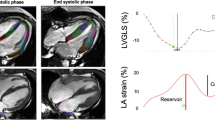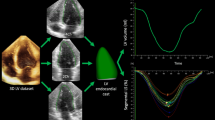Abstract
Impaired left-ventricular (LV) and right-ventricular (RV) cardiac magnetic resonance (CMR) strain has been documented in systemic sclerosis (SSc). However, it is unknown whether the CMR strain is predictive of adverse outcomes in SSc. Therefore, we set out to investigate the prognostic value of CMR strain in SSc. Patients with SSc who underwent CMR for clinical indications between 11/2010 and 07/2020 were retrospectively studied. LV and RV strain was evaluated by feature tracking. The association between strain, late gadolinium enhancement (LGE), and survival was evaluated with time to event and Cox-regression analyses. During the study period, 42 patients with SSc (age: 57 ± 14 years, 83% female, 57% limited cutaneous SSc, SSc duration: 7 ± 8 years) underwent CMR. During the median follow-up of 3.6 years, 11 patients died (26%). Compared to surviving patients, patients who died had significantly worse LV GLS (− 8.2 ± 6.2% versus − 12.1 ± 2.9%, p = 0.03), but no difference in LV global radial, circumferential, or RV strain values. Patients within the quartile of most impaired LV GLS (≥ − 12.8%, n = 10) had worse survival when compared to patients with preserved LV GLS (< − 12.8%, n = 32, log-rank p = 0.02), which persisted after controlling for LV cardiac output, LV cardiac index, reduced LV ejection fraction, or presence of LGE. In addition, patients who had both impaired LV GLS and LGE (n = 5) had worse survival than patients with LGE or impaired GLS alone (n = 14) and compared to those without any of these features (n = 17, p = 0.003). In our retrospective cohort of patients with SSc undergoing CMR for clinical indications, LV GLS and LGE were found to be predictive of overall survival.




Similar content being viewed by others
Data availability
The authors confirm that the data in the present study are available within the article and supplementary materials. Raw data are available on request from the corresponding author.
References
Varga J, Abraham D (2007) Systemic sclerosis: a prototypic multisystem fibrotic disorder. J Clin Invest 117(3):557–567
Feher A, Boutagy NE, Oikonomou EK et al (2021) Association between impaired myocardial flow reserve on (82)Rubidium positron emission tomography imaging and adverse events in patients with autoimmune rheumatic disease. Circ Cardiovasc Imaging 14(9):e012208
Feher A, Boutagy NE, Oikonomou EK et al (2021) Impaired myocardial flow reserve on (82)Rubidium positron emission tomography/computed tomography in patients with systemic sclerosis. J Rheumatol 48(10):1574–1582
Markousis-Mavrogenis G, Koutsogeorgopoulou L, Katsifis G et al (2020) The doubled-edged sword of T1-mapping in systemic sclerosis-a comparison with infectious myocarditis using cardiovascular magnetic resonance. Diagn (Basel) 10(5):335
Tennoe AH, Murbraech K, Andreassen JC et al (2018) Left ventricular diastolic dysfunction predicts mortality in patients with systemic sclerosis. J Am Coll Cardiol 72(15):1804–1813
Tyndall AJ, Bannert B, Vonk M et al (2010) Causes and risk factors for death in systemic sclerosis: a study from the EULAR scleroderma trials and research (EUSTAR) database. Ann Rheum Dis 69(10):1809–1815
Hachulla AL, Launay D, Gaxotte V et al (2009) Cardiac magnetic resonance imaging in systemic sclerosis: a cross-sectional observational study of 52 patients. Ann Rheum Dis 68(12):1878–1884
Elhai M, Meune C, Boubaya M et al (2017) Mapping and predicting mortality from systemic sclerosis. Ann Rheum Dis 76(11):1897–1905
Salerno M, Sharif B, Arheden H et al (2017) Recent advances in cardiovascular magnetic resonance: techniques and applications. Circ Cardiovasc Imaging. https://doi.org/10.1161/CIRCIMAGING.116.003951
Zhang KW, French B, May Khan A et al (2014) Strain improves risk prediction beyond ejection fraction in chronic systolic heart failure. J Am Heart Assoc 3(1):e000550
Moysidou GS, Dara A, Arvanitaki A et al (2023) Understanding and managing cardiac involvement in systemic sclerosis. Expert Rev Clin Immunol 19(3):293–304
Hinze AM, Perin J, Woods A et al (2022) Diastolic dysfunction in systemic sclerosis: risk factors and impact on mortality. Arthritis Rheumatol 74(5):849–859
Markousis-Mavrogenis G, Sfikakis PP, Koutsogeorgopoulou L et al (2021) Cardiovascular magnetic resonance reveals cardiac pathophysiology in autoimmune rheumatic diseases. Mediterr J Rheumatol 32(1):15–20
Bratis K, Lindholm A, Hesselstrand R et al (2019) CMR feature tracking in cardiac asymptomatic systemic sclerosis: clinical implications. PLoS ONE 14(8):e0221021
Lindholm A, Hesselstrand R, Radegran G, Arheden H, Ostenfeld E (2019) Decreased biventricular longitudinal strain in patients with systemic sclerosis is mainly caused by pulmonary hypertension and not by systemic sclerosis per se. Clin Physiol Funct Imaging 39(3):215–225
Kobayashi Y, Kobayashi H et al (2016) Detection of left ventricular regional dysfunction and myocardial abnormalities using complementary cardiac magnetic resonance imaging in patients with systemic sclerosis without cardiac symptoms: a pilot study. Intern Med 55(3):237–243
Sato T, Ambale-Venkatesh B, Lima JAC et al (2018) The impact of ambrisentan and tadalafil upfront combination therapy on cardiac function in scleroderma associated pulmonary arterial hypertension patients: cardiac magnetic resonance feature tracking study. Pulm Circ 8(1):2045893217748307
Cusma Piccione M, Zito C, Bagnato G et al (2013) Role of 2D strain in the early identification of left ventricular dysfunction and in the risk stratification of systemic sclerosis patients. Cardiovasc Ultrasound 11:6
Saito M, Wright L, Negishi K, Dwyer N, Marwick TH (2018) Mechanics and prognostic value of left and right ventricular dysfunction in patients with systemic sclerosis. Eur Heart J Cardiovasc Imaging 19(6):660–667
van den Hoogen F, Khanna D, Fransen J et al (2013) 2013 classification criteria for systemic sclerosis: an American college of rheumatology/European league against rheumatism collaborative initiative. Ann Rheum Dis 72(11):1747–1755
Petersen SE, Khanji MY, Plein S, Lancellotti P, Bucciarelli-Ducci C (2019) European association of cardiovascular imaging expert consensus paper: a comprehensive review of cardiovascular magnetic resonance normal values of cardiac chamber size and aortic root in adults and recommendations for grading severity. Eur Heart J Cardiovasc Imaging 20(12):1321–1331
Higgins AY, Arbune A, Soufer A et al (2021) Left ventricular myocardial strain and tissue characterization by cardiac magnetic resonance imaging in immune checkpoint inhibitor associated cardiotoxicity. PLoS ONE 16(2):e0246764
Friedrich MG, Sechtem U, Schulz-Menger J et al (2009) Cardiovascular magnetic resonance in myocarditis: a JACC white paper. J Am Coll Cardiol 53(17):1475–1487
Ferreira VM, Schulz-Menger J, Holmvang G et al (2018) Cardiovascular magnetic resonance in nonischemic myocardial inflammation: expert recommendations. J Am Coll Cardiol 72(24):3158–3176
Giri S, Chung YC, Merchant A et al (2009) T2 quantification for improved detection of myocardial edema. J Cardiovasc Magn Reson 11:56
Adabag AS, Maron BJ, Appelbaum E et al (2008) Occurrence and frequency of arrhythmias in hypertrophic cardiomyopathy in relation to delayed enhancement on cardiovascular magnetic resonance. J Am Coll Cardiol 51(14):1369–1374
Yang H, Negishi K, Wang Y, Nolan M, Saito M, Marwick TH (2016) Echocardiographic screening for non-ischaemic stage B heart failure in the community. Eur J Heart Fail 18(11):1331–1339
Guerra F, Stronati G, Fischietti C et al (2018) Global longitudinal strain measured by speckle tracking identifies subclinical heart involvement in patients with systemic sclerosis. Eur J Prev Cardiol 25(15):1598–1606
Yiu KH, Schouffoer AA, Marsan NA et al (2011) Left ventricular dysfunction assessed by speckle-tracking strain analysis in patients with systemic sclerosis: relationship to functional capacity and ventricular arrhythmias. Arthritis Rheum 63(12):3969–3978
Jiang X, Zhang F, Li Y et al (2021) Clinical assessment of cardiac impairment favored by two-dimensional speckle tracking echocardiology in patients with systemic sclerosis. Rheumatol (Oxford). https://doi.org/10.1093/rheumatology/keab724
Spethmann S, Rieper K, Riemekasten G et al (2014) Echocardiographic follow-up of patients with systemic sclerosis by 2D speckle tracking echocardiography of the left ventricle. Cardiovasc Ultrasound 12:13
Vo HQ, Marwick TH, Negishi K (2018) MRI-derived myocardial strain measures in normal subjects. JACC Cardiovasc Imaging 11(2 Pt 1):196–205
Plana JC, Galderisi M, Barac A et al (2014) Expert consensus for multimodality imaging evaluation of adult patients during and after cancer therapy: a report from the American society of echocardiography and the European association of cardiovascular imaging. J Am Soc Echocardiogr 27(9):911–939
Overhoff D, Ansari U, Hohneck A et al (2022) Prediction of cardiac events with non-contrast magnetic resonance feature tracking in patients with ischaemic cardiomyopathy. ESC Heart Fail 9(1):574–584
Kammerlander AA, Dona C, Nitsche C et al (2020) Feature tracking of global longitudinal strain by using cardiovascular MRI improves risk stratification in heart failure with preserved ejection fraction. Radiology 296(2):290–298
Romano S, Judd RM, Kim RJ et al (2017) Association of feature-tracking cardiac magnetic resonance imaging left ventricular global longitudinal strain with all-cause mortality in patients with reduced left ventricular ejection fraction. Circulation 135(23):2313–2315
Fischer K, Obrist SJ, Erne SA et al (2020) Feature tracking myocardial strain incrementally improves prognostication in myocarditis beyond traditional CMR imaging features. JACC Cardiovasc Imaging 13(9):1891–1901
Podlesnikar T, Pizarro G, Fernandez-Jimenez R et al (2020) Five-year outcomes and prognostic value of feature-tracking cardiovascular magnetic resonance in patients receiving early prereperfusion metoprolol in acute myocardial infarction. Am J Cardiol 133:39–47
Eitel I, Stiermaier T, Lange T et al (2018) Cardiac magnetic resonance myocardial feature tracking for optimized prediction of cardiovascular events following myocardial infarction. JACC Cardiovasc Imaging 11(10):1433–1444
Li X, Li J, Lin L et al (2020) Left and right ventricular myocardial deformation and late gadolinium enhancement: incremental prognostic value in amyloid light-chain amyloidosis. Cardiovasc Diagn Ther 10(3):470–480
Mukherjee M, Chung SE, Ton VK et al (2016) Unique abnormalities in right ventricular longitudinal strain in systemic sclerosis patients. Circ Cardiovasc Imaging 9(6):e003792
Pokeerbux MR, Giovannelli J, Dauchet L et al (2019) Survival and prognosis factors in systemic sclerosis: data of a French multicenter cohort, systematic review, and meta-analysis of the literature. Arthritis Res Ther 21(1):86
Mousseaux E, Agoston-Coldea L, Marjanovic Z et al (2018) Left ventricle replacement fibrosis detected by cmr associated with cardiovascular events in systemic sclerosis patients. J Am Coll Cardiol 71(6):703–705
Funding
This research was supported by the National Institute of Arthritis and Musculoskeletal and Skin Diseases of the National Institutes of Health (NIH) under Award No. R01 AR073270 (MH) and by the National Center for Advancing Translational Science under Award No. UL1 TR001863 (LAB).
Author information
Authors and Affiliations
Contributions
AF and LAB conceived this study, collection of data, and critical review of the manuscript: AF, EJM, DCP, HRM, AJS, MH, and LAB; AF analyzed data, drafted the manuscript, and designed the figures. All authors have read and approved the final manuscript. All authors take full responsibility for the integrity of all aspects of the work.
Corresponding author
Ethics declarations
Conflict of interest
The authors declare that they have no conflict of interest.
Additional information
Publisher's Note
Springer Nature remains neutral with regard to jurisdictional claims in published maps and institutional affiliations.
Supplementary Information
Below is the link to the electronic supplementary material.
Rights and permissions
Springer Nature or its licensor (e.g. a society or other partner) holds exclusive rights to this article under a publishing agreement with the author(s) or other rightsholder(s); author self-archiving of the accepted manuscript version of this article is solely governed by the terms of such publishing agreement and applicable law.
About this article
Cite this article
Feher, A., Miller, E.J., Peters, D.C. et al. Impaired left-ventricular global longitudinal strain by feature-tracking cardiac MRI predicts mortality in systemic sclerosis. Rheumatol Int 43, 849–858 (2023). https://doi.org/10.1007/s00296-023-05294-6
Received:
Accepted:
Published:
Issue Date:
DOI: https://doi.org/10.1007/s00296-023-05294-6




